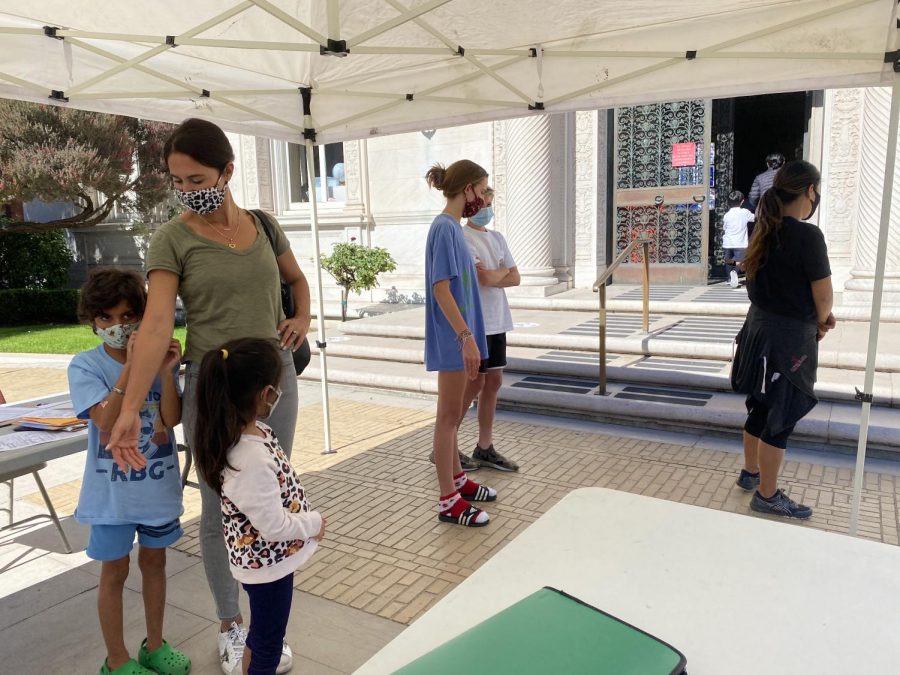No resting with testing
Coronavirus testing offered on campus
Families and students wait in line for coronavirus testing outside of Flood on Broadway. Convent & Stuart Hall has offered testing for families, faculty and staff since September as students begin to resume in-person learning.
October 26, 2020
In anticipation of the possibility of returning to in-person learning in the next few weeks, senior Eloise Laluyaux made the drive to the signature white marble mansion for the first time since last spring to get a coronavirus test.
“I think they were good about COVID precautions with all staff wearing masks and a very limited number of people inside the Flood building, and the staff were wearing masks,” Laluyaux said about getting tested at school. “It was also pretty nice being able to visit campus too after doing online school for so long.”
Younger students, staff and faculty that have returned to campus, as well as older students preparing for their return, are being tested using RT-PCR test screening either through the nose, or the inner cheek swab if under the age of 12. The school also offers access to the antibody test.
“Currently the school is offering weekly COVID-19 testing through a company called Agile Force who specialize in on-site testing events,” school nurse Katie Colman said. “In the coming weeks, the school will continue to offer on-campus testing while students return to school.”
With the elementary school already back on campus, Grades K-6 are required to get tested every four to six weeks, Grades 7-8 are required to test monthly, and the high school will require testing at least every two weeks, although every week is ideal, according to President Ann Marie Krejcarek who answered frequently asked questions on the school’s Health and Safety Plan page.
“Getting tested was really efficient and easy, but it was uncomfortable,” sophomore Samantha Calvin said, “but I think if getting tested weekly meant we got to go back to school in person, I would definitely do that.”
The diagnostic RT-PCR test provided on campus is a molecular test that detects the virus’ genetic material to determine if someone is positive for coronavirus. The nasal swab is recommended, as the test produces fewer false negatives in comparison to tests done with saliva, according to Harvard Medical School.
“We have two characteristics that we look for reliability — called sensitivity — and specificity,” George Rutherford, an epidemiology professor at University of San Francisco Medical School, said. “Sensitivity refers to the proportion of tests that are truly positive that you detect. Sensitivity is sort of the opposite and the question is, ‘What proportion of the truly negatives does the test classify as truly negative?’”
As researchers learn more about the coronavirus, new and more efficient tests are continuing to be developed with an improved dependability. False negatives in RT-PCR report that the virus is not present when in reality a patient is infected.
“Agile Force implements the mid-nares RT-PCR test,” Coleman said, referring to the area of the nasal cavity that is swabbed. “Studies have shown that frequent testing of a population of individuals is effective in reducing the spread of COVID-19.”
False negatives with other tests occur between 2-37%, which creates a large gap in a test’s reliability, according to Harvard Medical School. The RT-PCR test given on campus tends to be the most reliable, according to Rutherford, with the highest sensitivity to the virus.
“I do think the test is quite reliable,” senior Kate Baker said. “I feel very safe at the school testing site as they have a careful check-in procedure, and those who actually do the blood and nose tests are very professional.”
The antibody test using blood samples also has inconsistencies because it takes one to three weeks for antibodies to form, so individuals testing negative could be potentially infected. Although rare, the test may generate a positive result for a virus in the same coronavirus family, according to the CDC.
“The antibody tests don’t turn positive until about 12 days after infection, so they’re not very helpful for making diagnoses.” Rutherford said. “They’re more helpful for people who want to understand where the virus has gone.”
Tests taken on campus have results available within the week, and tests are billed to insurance with RT-PCR costs about $100, according to Rutherford. This eliminates financial burdens on families, especially in the frequency students will have to be tested in order to attend in-person learning, according to the United States Department of Health and Human Services.
“The process was super easy and didn’t take long,” junior Amelia Abernethy said. “It was very helpful that the school provided the tests, otherwise I wouldn’t have gotten tested.”
Frequent testing of all individuals, social distancing, one-way population flow patterns, face masks, face shields, daily screening of all individuals on campus, hand sanitizer throughout the school and complete sanitization of HVAC and duct systems, are the eight levels of protection necessary for the school to follow in order to operate in-person learning, according to Coleman. Testing updates and outlined precautions are available via the school’s Health and Safety Plan page.
“I think it was a lot easier and more accessible for us to sign up through school,” Laluyaux said. “I feel a lot safer going to school knowing that they’re taking precautions.”










